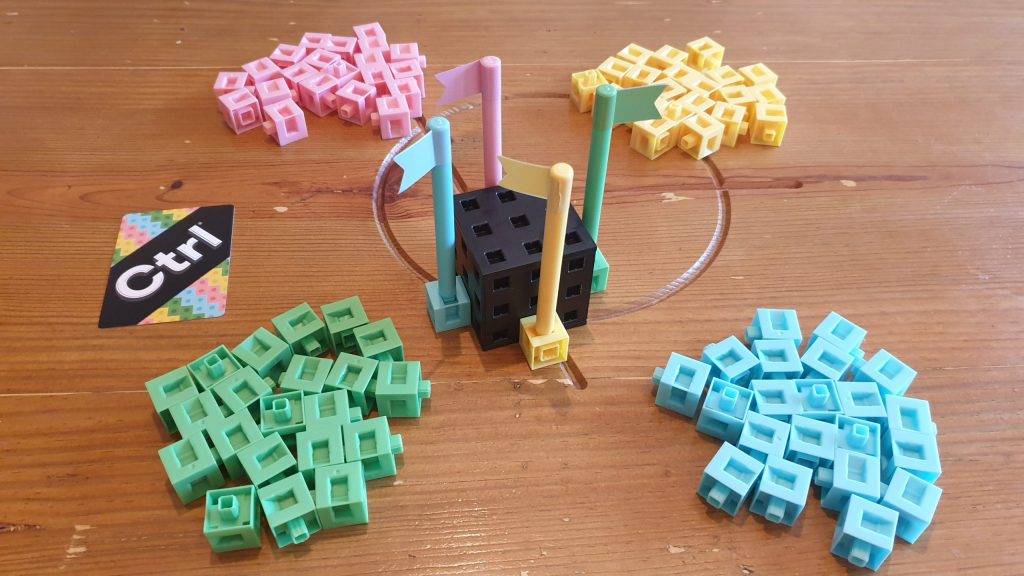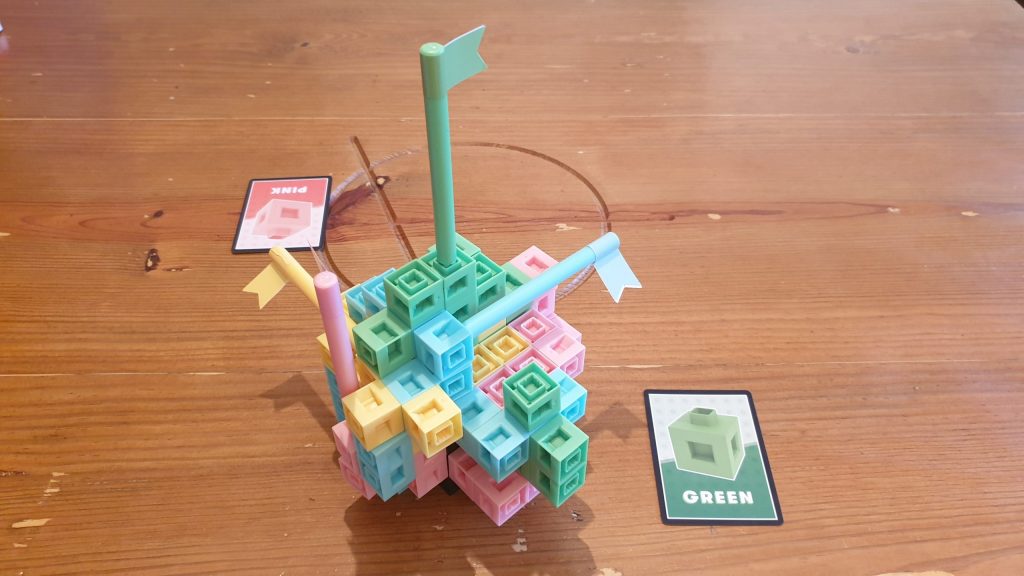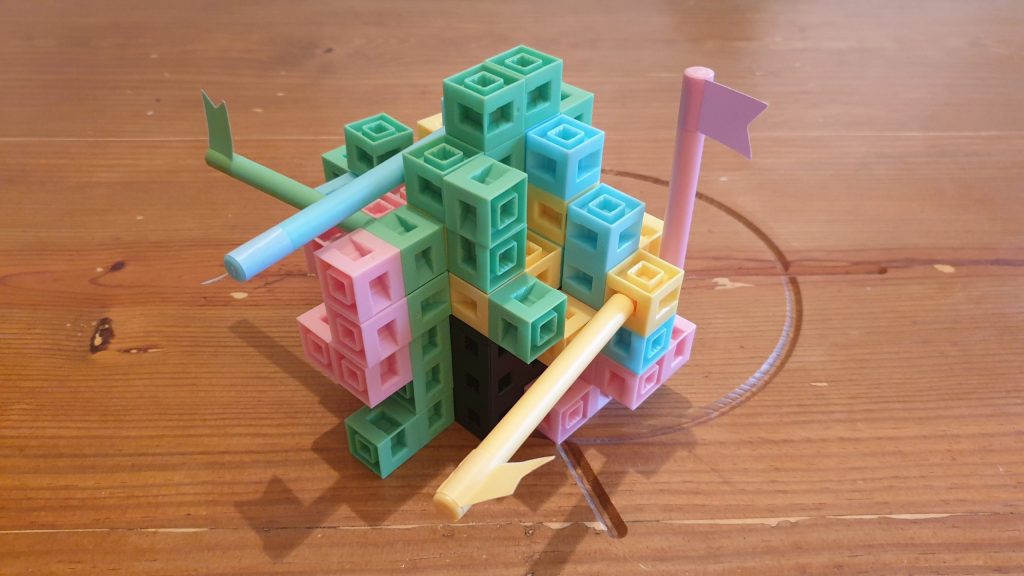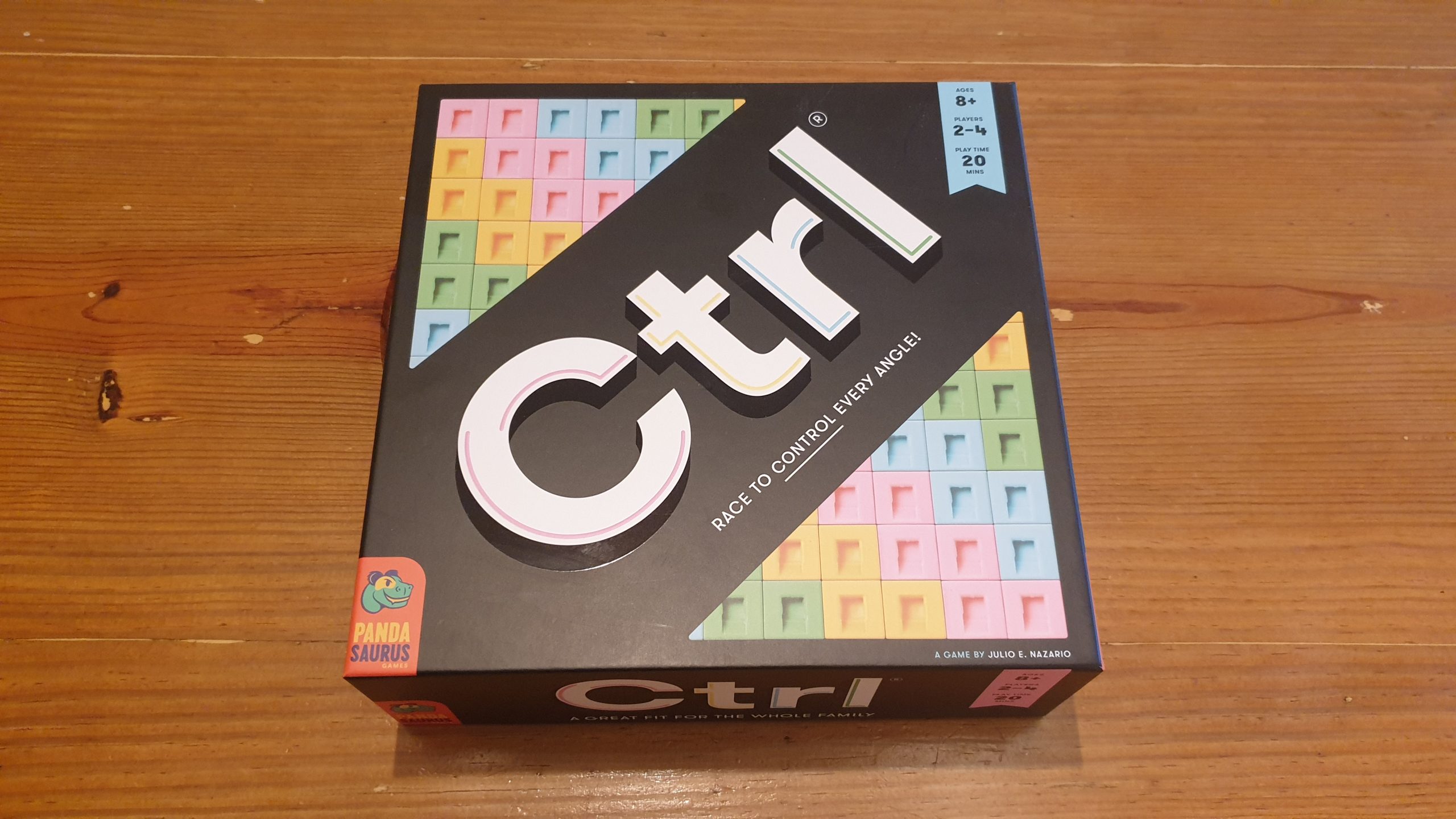Ctrl is a brand new 3D strategy, puzzle like board game from publisher Pandasaurus Games. Designed by Julio E. Nazario, the game sees 2 – 4 players vying for control of the battlefield, a 3×3 central cube, for around 20 minutes. Using 3 blocks at a time, players will build up areas of control, build over opponents blocks and perhaps even bluff with a second colour. However, will the game gain Ctrl of a space on my gaming shelf? Let’s find out!
Starting out each player takes the 22 blocks in one of the four colours, also taking the flag of that colour. If playing with only 2 people then both take two colours, secretly choosing which they will score at the end of the game by keeping the card of that colour. The setup positions are denoted in the rulebook, depending on the player count to space players out. These see a single block and the flag of each player added to the battlefield. Apart from putting the battlefield cube in the center of the table the game is ready to play!
Each turn follows the same 3 steps. Step 1 is simply to remove your flag from its current location. Step 2 is the most important as it involves adding 3 blocks to the battlefield. The player chooses any of their blocks on the battlefield and adds a block from their supply adjacent to it. Choosing a direction they must then add two additional blocks in a straight line from the first, while keeping in mind a few rules. The direction of the additional blocks must not be directly away from the battlefield, with blocks wrapping around when the edges are reached. Blocks can however step up and down 1 height gaps/humps, with the blocks pushed into the main cube.

The final step of a turn is to place your flag onto any of your blocks, pointing in any direction other than downwards. Opponent’s flags will stop you building in a direction but also stop players scoring points at the end of the game. Throughout the game players will see their coloured blocks journey up, over and around the battlefield. Importantly, the size of areas players control doesn’t directly result in points.
At the end of the game, players will score points based upon how many of their blocks can be seen, across 5 different directions (the sides and the top). For each direction, discounting blocks hidden by opponents’ flags, players earn a point per block that can be seen. Combining the points earnt for each direction, the winner is the player with the most points. In the case of a tie, something I have yet to see, whoever’s flag is highest is the winner.
Over the course of a game of Ctrl players will take a total of 7 turns per colour. This means that a 2 player game isn’t dramatically shorter than a 3 – 4 player game, as they control two colours. 7 turns may sound very low but each turn you’ll place 3 blocks. While this doesn’t quite multiply to become 21 choices it does expand the choice. With the three blocks in a line a variety of options present themselves, from simply spreading out to covering opponents’ blocks.
It can be quite hard, especially for first time players, to see how early game choices impact the end score. A lot of the initially placed blocks will eventually be covered, potentially from all angles. After a few games however players will realise quite how important those early moves are, setting themselves up in a good position for future turns. For example, a placement could dissuade another player from charging blocks towards them around the battlefield. Despite being able to spin the battlefield around and look from all angles, some still find it hard to visualise how a move will help them score. Ebbing away after a couple of games, this has put a couple of people off the game. For the rest, the game is short enough that participating in a learning game isn’t that much of a stumbling block.

When going through the rulebook it is hard to visualise the rules of building away from the battlefield, though there are helpful images for wrapping around options and stepping up and down. Getting hands on with the blocks, even if it is the first turn of a game, this soon dissolves any issues. It just makes sense with the battlefield in front of you. Also, it makes more sense why being unable to build directly away from the battlefield is a rule in the first place. It forces competition for the top of the hill, as it can be seen from all 5 scoring directions.
When a game has a 2 player variant it is often a point of concern. In Ctrl this is flipped around as it offers the best experience. With 4 there is a sort of chaos to the game, with 9 blocks placed between turns. This has the potential to vastly change the look of the battlefield between turns, and leaves players waiting until it is their turn to determine their next move. At two there is no less competition, thanks to both players having control of two colours. Players can bluff which is the colour they want to be seen more, use one colour to attempt to block the opponent and there are more opportunities to tactically flag. The game time isn’t drastically changed either, though there are less pauses making it seem faster.
As production quality goes Ctrl looks as if it should be Lego brick awesome. The colours used for the bricks makes them easily distinguishable. Popping together and into the main cube like Lego bricks, the blocks give the title a striking look. Unfortunately, the structure is never quite as sturdy as connected blocks of lego. Towards the end of the game the structure that seemed strong to begin with starts to show signs of weakness – which is amplified by the flags being pulled out and pushed in.

During play the flag poles are prone to falling out, if the structure is spun around – something players need to do to see the battlefield from all angles. On top of this, the flags on the poles are flimsy stickers. Putting aside the chance there is to stick them on incorrectly – as you’ll have to attach them before playing – they are certainly the weakest part of the game. What makes this more of a shame is that their gameplay significance, the ability to block movement or placements, made them an exciting prospect.
The production budget was clearly spent on the blocks. This is evident as Pandasaurus has chosen to not include a scoresheet, nor any form of storage solution. While scoresheets aren’t always included in other games, there is a picture of a scoresheet in the rulebook. Alas, this is only one that can be downloaded and printed off. With 88 blocks, 4 cards, the battlefield and the flags, with their delicate stickers, you’d expect an insert or bags, or something. Yet, nothing is provided, so it all just rattles around the box.
Ctrl is a game where the premise is much better than the result, as unfortunately it is the production that lets the experience down. It looks like a bunch of solid blocks that should build together into a strong structure. As soon as flags or block sections come off it disrupts the flow of the game. When you have to start worrying about carefully placing things you start to get drawn out of the immersion of the puzzle that presents itself. The gameplay is an enjoyable strategic puzzle, it just isn’t one that grabs players making them want to replay over and over again. Ctrl may still be for you but this is a game I’d recommend trying before buying.
(Editor’s Note: Ctrl was provided to us by Asmodee for the review. The game is currently available from local board game stores! Find your local store here.)

